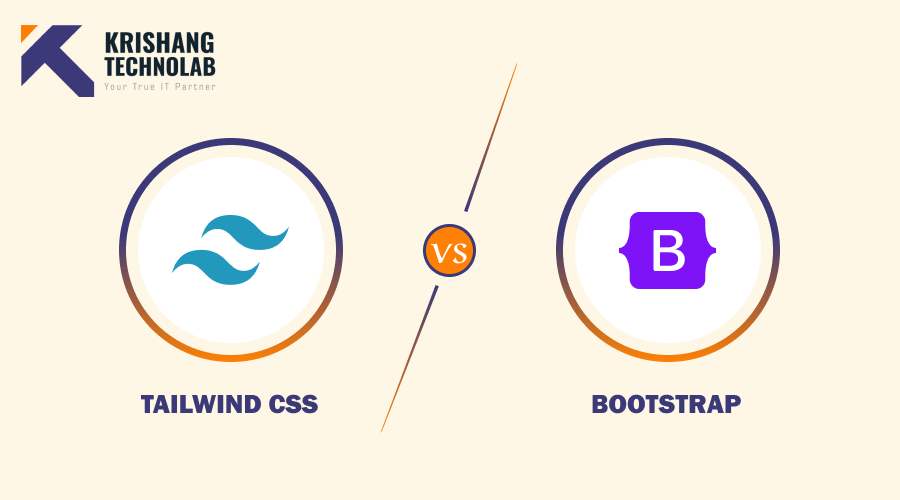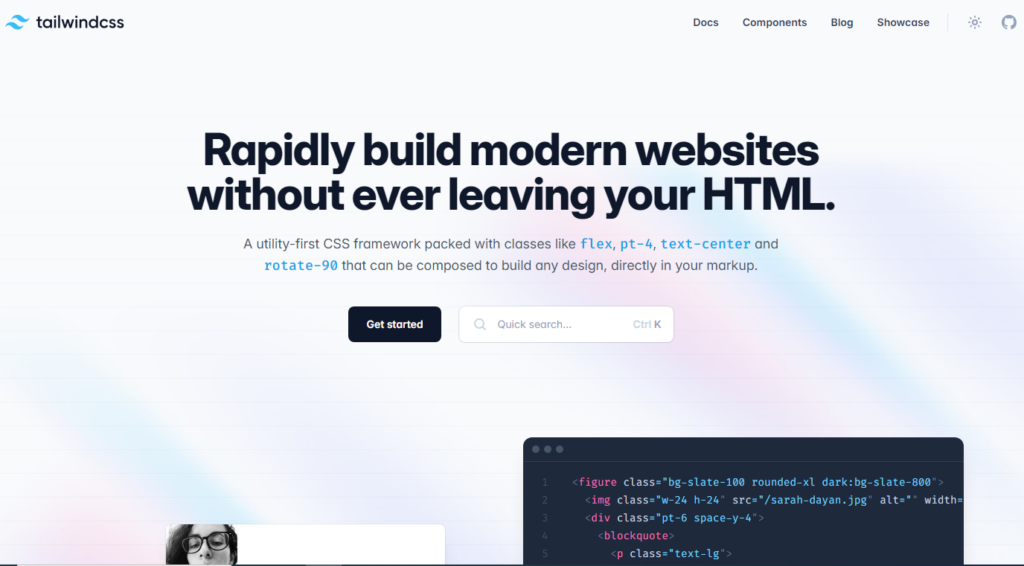TailWind CSS vs. Bootstrap: Which CSS Framework is Best?
 Krishang Technolab
Krishang Technolab
In the ever-changing realm of web development, the look, functionality, and user experience of a website creation may all be greatly impacted by the CSS framework selection. Both Tailwind CSS and Bootstrap are formidable competitors in the field. Both TailWind CSS and Bootstrap are frameworks that provide distinct methods to layout and styling, meeting a variety of project needs and developer preferences. The topic of which CSS framework is best still needs to be answered.
Two well-liked choices for selecting a CSS framework for your web development projects are Tailwind CSS and Bootstrap. Each framework has unique qualities and advantages that meet various requirements. We will contrast TailWind CSS with Bootstrap in this blog article so you can decide which is better for your upcoming project. Let's examine the main distinctions and benefits of each framework.
What is Tailwind CSS?

Tailwind CSS is a utility-first CSS framework that gives you complete control over the design of your website. Instead of relying on predefined components, Tailwind CSS allows you to create custom styles using utility classes. This approach offers flexibility and makes it easy to maintain a consistent design system.
Pros of Tailwind CSS
Very adaptable: Tailwind CSS makes it possible to take a very adaptable approach to site design. Tailwind allows you to directly style components utilizing utility classes rather than depending on pre-defined styles and classes. In this manner, you may make a genuinely unique website and have complete control over every element of its design.
Effective development process: By removing the need to write bespoke CSS and reusing utility classes, Tailwind CSS development allows you to accelerate your development process. Over time, this results in code that is clearer and more effective, which makes updating and maintaining your website simpler.
Mobile-friendly: Tailwind CSS was created with mobile devices in mind, so it is optimized for them right away. This guarantees that your website will work flawlessly and look fantastic on all screen sizes.
Cons of Tailwind CSS
steep learning curve: Tailwind CSS has a high learning curve since it is so adaptable. Learning the many utility classes and how to utilize them efficiently may take some time for novices.
Tailwind CSS could not be the greatest option for straightforward or little tasks, even though it's excellent for producing original and customized designs. It could be wiser in some situations to use a more conventional CSS framework, such as Bootstrap.
When to Use TailWind CSS
Highly Custom Designs: With utility-first methodology, which enables accurate and in-depth style, makes it perfect for projects requiring a distinctive and customized look.
Performance Optimization: TailWind CSS ability to remove unnecessary CSS can help projects that require a high level of performance optimization by reducing file sizes and speeding up load times.
Rapid Prototyping: With TailWind CSS is a strong option for projects that need frequent design changes and rapid prototyping since it enables quick styling and iterative design.
Scalability: To preserve uniformity and effectiveness throughout the codebase, large projects with intricate and scalable design systems can make use of TailWind configuration files.
What is Bootstrap?
The more conventional CSS framework Bootstrap, on the other hand, offers a collection of pre-made elements and styles. Developers wishing to quickly create responsive websites frequently use it because of its well-known simplicity of use and comprehensive documentation.
Pros of Bootstrap
Simple to use: Beginners may easily get started with Bootstrap because to its extensive collection of pre-built components and styles. Since most style is done with HTML classes, you don't need to know a lot about CSS.
Responsive design: Bootstrap, like Tailwind CSS, prioritizes mobile devices. It has a responsive grid architecture that makes it easy for your website to adjust to various screen sizes.
Huge community support: If you run into problems or need to add new features to your website, you can readily access tools and assistance thanks to Bootstrap's sizable and vibrant developer community.
Cons of Bootstrap
Restricted customisation: Bootstrap offers fewer customization choices than Tailwind CSS. It might be time-consuming and laborious to modify Bootstrap's default styles if you want to build a unique look.
Bloated code: Many pre-defined styles and components included with Bootstrap may not be utilized in your project. Your website's performance may suffer as a result of bloated code.
When to Use Bootstrap
Rapid Development: Bootstrap's responsive grid structure and ready-to-use components are useful for projects that must be completed rapidly.
Consistency Across Projects: Teams working on several projects might benefit from Bootstrap's ability to guarantee a consistent design language across projects.
Lack of Design Resources: Teams with little to no design expertise may use Bootstrap's pre-made components to produce websites that appear great without requiring a lot of design effort.
Large-Scale Applications: Bootstrap is a great option for projects that need a solid, tried-and-true framework with a wealth of documentation and community support.
TailWind CSS vs Bootstrap: Feature-Based Comparison
Performance
Tailwind CSS is the best in terms of performance. Compared to Bootstrap, which has a bigger and more complicated codebase, it produces a smaller and more efficient CSS file since it only applies the styles required for a particular element. Tailwind CSS could be a better choice for projects that demand great performance.
Personalization
The customization strategy is one of the main distinctions between Tailwind CSS and Bootstrap. You may quickly include Bootstrap's pre-made styles and components into your project. If you're not cautious, this might result in a cookie-cutter appearance even if it can be practical for getting up and running fast.
Size of the File
Tailwind CSS is the clear winner in terms of file size. Unlike Bootstrap, Tailwind CSS is utility-based, so you just include the styles you need, which reduces the total file size. Faster load times and better website performance may result from this.
Learning Curve
Because of its longevity and sizable developer community, Bootstrap makes it simpler to get tools and assistance when you encounter problems. However, Bootstrap may have a high learning curve, particularly for new users. However, because of its simple utility classes, Tailwind CSS has a more smooth learning curve. Beginners may find it simpler to begin front-end development as a result.
Flexibility
In terms of flexibility, Tailwind CSS shines. With Tailwind CSS, you have complete control over every aspect of your design, allowing you to create truly unique and customized websites. Bootstrap, on the other hand, can feel more restrictive due to its pre-designed components and styles. If you’re looking for more creative freedom, hire Tailwind CSS development company might be the better choice for you.
Strengths
In terms of use cases, each framework has advantages. For intricate and unique designs, Tailwind CSS might be a great option, whilst Bootstrap can be the best option for straightforward and responsive layouts. To choose the best framework for you, take into account the project specifications as well as your coding tastes.
Which one will you utilize for your next project, Tailwind CSS or Bootstrap?
You may already know the answer to this post's question, but in the end, your own tastes, degree of CSS proficiency, and the situation will determine the CSS framework you use—or not use at all. Bootstrap may be the best option if you're not a designer and want to rapidly and easily create a user interface for consumers. However, if you want complete creative control over your design and the ease of generating own styles and components, Tailwind CSS is a better choice.
We are a leading web development company that specializes tailwind css development services in utilizing the Tailwind CSS framework to create cutting-edge, responsive web apps. Our skilled dedicated development team for hire produces beautiful designs and guarantees a smooth connection with Tailwind, resulting in websites that are both excellent and aesthetically pleasing.
Source : https://www.krishangtechnolab.com/tailwind-css-vs-bootstrap/
Subscribe to my newsletter
Read articles from Krishang Technolab directly inside your inbox. Subscribe to the newsletter, and don't miss out.
Written by

Krishang Technolab
Krishang Technolab
We are a corporation that creates Professional IT development Services. Our team consists of skilled individuals that are developing the future of IT today!